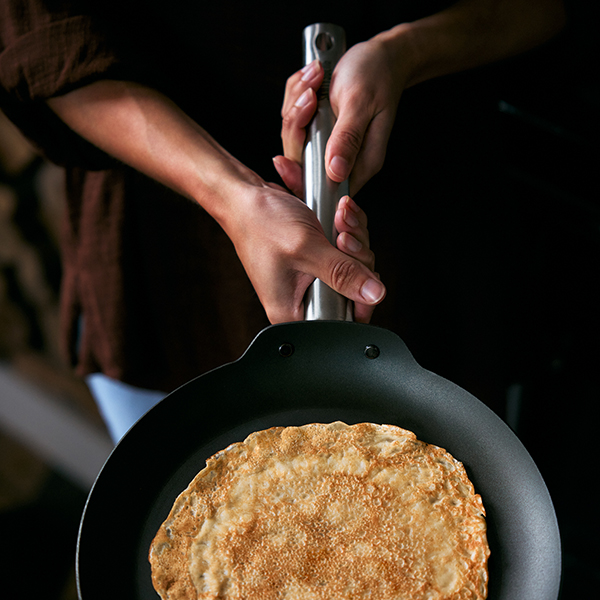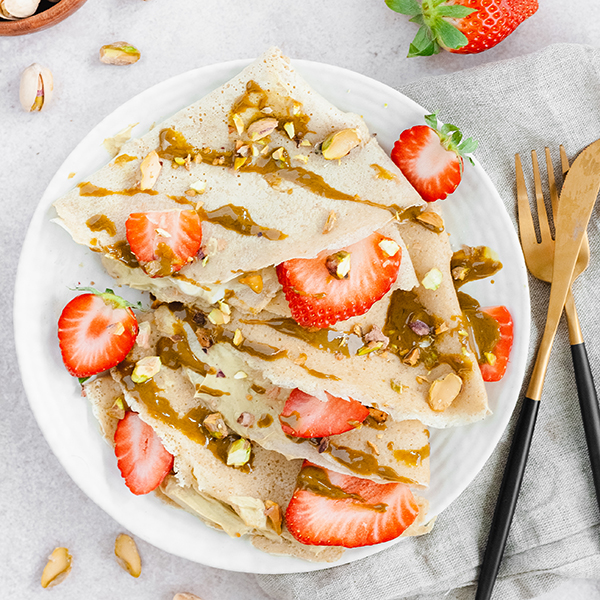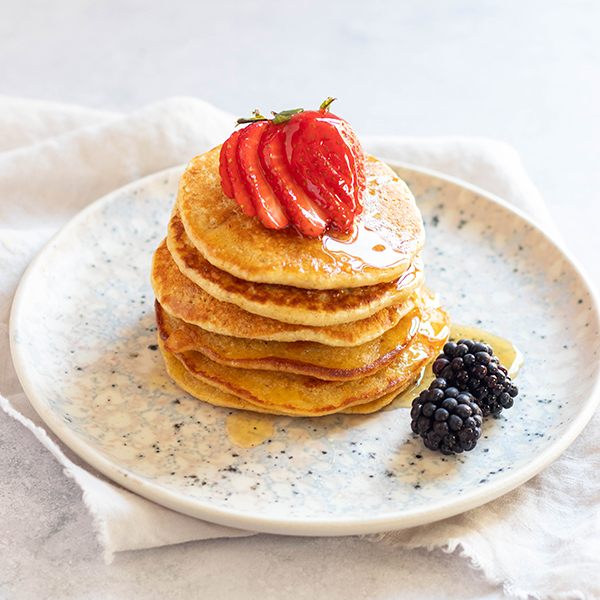Pancakes are a beloved dish all over the world, and the good news is that you can easily make them at home. Moreover, whether you're a beginner in the kitchen or a seasoned pancake baker doesn't matter. With a few handy tips & tricks - from choosing the right ingredients to mastering the art of flipping - you'll be putting pancakes on the table that are every bit restaurant-worthy from now on.
1 | From pancake pan to fresh egg: use the right tools
If you go for the tastiest pancakes, then of course you choose the best "tools.
- With a real pancake pan, you can be sure you're in the right place. Such a pan has a thick bottom so that the heat spreads well over the entire surface of the pan. This makes your pancakes less likely to burn. This type of pan also has not too high edges to make flipping the pancakes easier. By the way, do choose one that is suitable for your heat source. For example, if you have an induction cooktop, get a pancake pan that is specifically designed for induction. If a real pancake pan is not an option, use a frying pan.
- With a whisk or mixer and a large batter bowl, you easily whisk the batter until fluffy. The choice is yours, but: done is done. If you keep on beating endlessly, you'll end up with tough pancakes, and that won't make anyone happy.
- Go for perfection and use only fresh ingredients. You'll find that your pancakes will be tastier than ever as a result. So get some brand-new eggs and don't use milk, butter or flour that is near its expiration date.
2 | The tastiest pancake batter
Pancake batter that you make yourself - that is, without ready-made mix - produces by far the tastiest pancakes. Besides, you don't have to be Gordon Ramsay to make a good batter, so on to the supermarket. For such a delicious dish as pancakes, the shopping list is surprisingly simple: 250 grams of wheat flour or flour (or buckwheat flour or almond flour), 2 eggs, 500 ml of milk and a pinch of salt. For baking, you'll also need oil or butter. With this you will make 10 medium-sized pancakes.
First sift the flour/flour. This prevents it from showing up as lumps in your batter. Make a well and pour in the eggs and half the milk. Then start stirring in the center of the batter bowl so that the flour gradually mixes with the eggs and milk. Once everything is mixed, add the rest of the milk.
Do you like them light and fluffy? Adding an extra egg will make your pancakes even fluffier. You can also beat the eggs briefly before mixing them with the flour/flour. Another way to make your pancakes a little less compact is to replace some of the milk with carbonated water or bier.
The last step is not a must, but recommended: cover the batter with cling film and let it rest in the refrigerator for at least 60 minutes. Why? It will give you smoother pancakes with a better texture.


3 | Flipping the pancakes
- You pour a large spoonful of batter into the pan. While rotating, you then spread the batter over the entire surface. If the top of the pancake is no longer liquid and the edges are browning, it's time to flip the pancake. This can be done by sliding a wide spatula under the pancake and using a quick motion to lift the pancake and flip it over. But if you want to compete with the real pancake bakers, leave the spatula to the side and flip your pancakes in the air with a smooth motion. Here's how to do it:
- Lift the pan and shake it to see if the pancake is completely loose on the bottom. If this is not the case, then part of the pancake on the bottom is not yet cooked or is just burnt on. Check to see which one it is and take action: wait a bit longer or use a spatula to pull the pancake off the bottom.
- Now make a forward motion that you end by raising the pan with a short motion. The pancake will detach from the pan and make a flick in the air. Make sure the pan is reasonably dry when you start flipping otherwise the cooking grease will be everywhere except in your pan.
- Lift the pancake pan slightly toward you again for a soft landing of your pancake in the pan. Note: one flip is enough, otherwise a tough pancake awaits you.
Important: Don't worry if the air flip doesn't work right the first time. Flipping a pancake and catching it again properly is a matter of lots of practice.
4 | Pancakes with cheese
There are endless variations with pancakes. The basic version is eaten with powdered sugar or syrup, but the variant with bacon or cheese is by far the favorite in the Netherlands. It is a bit tricky, though, because pancakes with filling are harder to flip because they are heavier. Also, the added ingredients are more likely to burn. This is how you keep your savory pancakes with cheese whole:
- Using a cheese slicer, cut enough slices of cheese and lay them out.
- Grease the pan and add the batter.
- Once the batter has filled the entire pan, you pull a slice of cheese through the batter. Then put the cheese on top of the pancake. You can also pull the cheese slice through the still liquid batter of your pancake with one side and then lay it down on your pancake with that batter side up.
- Ingredients that this trick does not work with, such as mushrooms and onion, fry first in another pan and sprinkle over the still liquid pancake at the same time as the cheese. That way they won't burn when you flip your savory pancake.


5 | First aid for pancake baking
Pancake batter is too thick or too thin
Once you notice that your batter is not flowing nicely through the pan or is just too runny, adjust the batter. The solution is simple: add a dash of milk or stir some extra flour into the batter.
The first pancake always fails
It is a persistent myth that the first pancake always fails. The secret is in the temperature of the pancake pan. Make sure you let the pan warm up over medium-high heat for at least three minutes before you start frying. A handy trick to check if the pan is hot enough is to splash a few drops of water on it. If these droplets bounce around the pan like balls, then you know it's time to start frying.
Pancakes burn to
Often pancakes are fried in (cream) butter. Do your pancakes burn regularly? If so, use oil instead of butter. While butter gives a nice flavor to your pancake, it also has a lower burning temperature than oil. If you don't want to miss the creamy taste of butter, make a mixture of oil and butter or choose a liquid butter with oil already added. If oil is a no-go, mix some melted butter into the batter or turn the heat down a notch.
Tomorrow we want again!
Any pancakes left over? What luck, because cold, with a layer of red jam on top, they taste at least as good. By the way, did you know that you can also freeze pancake batter and pancakes very well? The batter goes into an airtight bowl, of course. Pancakes are best frozen with some baking paper between them. This prevents them from freezing together.

